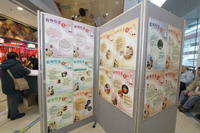
2010 3rd Issue
Feature Articles
To protect public health, Hong Kong has implemented the Nutrition Labelling Scheme which requires prepackaged food products to carry nutrition labels listing the content of energy and the seven nutrients specified for labelling. Nutrition labels, together with the information on food labels (e.g. list of ingredients, expiry date etc.), not only enable consumers to make smarter food choices but also prevent them from being misled by deceptive labels. Consumers can thus progress towards achieving a healthy diet.
Nevertheless, no matter how exhaustive the information on nutrition labels is, what's more important is we know how to read or use such information. To facilitate the general public in understanding nutrition labels, the Centre for Food Safety (CFS) has formulated a series of publicity and promotional programmes with a view to enhancing public knowledge regarding nutrition labelling through interactive educational and fun sharing activities.
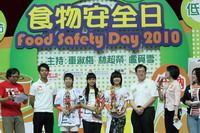 |
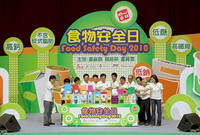 |
The Food and Drugs (Composition and Labelling) (Amendment: Requirements for Nutrition Labelling and Nutrition Claim) Regulation 2008 came into force on 1 July 2010. Organised by the CFS in collaboration with Radio Television Hong Kong, the Education Bureau and the Committee on Home-School Cooperation, Food Safety Day 2010 with the theme "For Your Health Count on the Nutrition Label 1+7" was held at the Hong Kong Southorn Stadium in Wan Chai on 28 June 2010 as a preface to Phase III of the Publicity and Education Campaign on Nutrition Labelling.
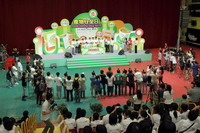 |
 |
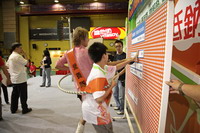 |
 |
To further publicise the information on nutrition labels across all sectors in the community, the CFS invited several hundred secondary school students and teachers and other guests to participate in Food Safety Day 2010. Through the various activities on that day, the youngsters were encouraged to make good use of nutrition labels so as to enjoy healthy living.
The guests officiating at the opening ceremony of Food Safety Day 2010 included Secretary for Food and Health Dr York Chow; Chairman of the Legislative Council Panel on Food Safety and Environmental Hygiene the Hon. Fred Li and Deputy Chairman the Hon. Wong Yung-kan; Director of Food and Environmental Hygiene Mr Cheuk Wing-hing; Controller of the CFS of the Food and Environmental Hygiene Department Dr Constance Chan; Head of Chinese Programme Service of Radio Television Hong Kong Mr Philip Chow; Principal Education Officer (Curriculum Development) of the Curriculum and Quality Assurance Branch of the Education Bureau Mr Tam Koon-che; member of the Committee on Home-School Co-operation Mr Christopher Yu; Chairman of the Expert Committee on Food Safety Professor Kwan Hoi-shan; Chief Executive of the Consumer Council Ms Connie Lau; Chairman of the Hong Kong Dietitians Association Ms Sylvia Lam; President of the Hong Kong Nutrition Association Mr Terry Ting; and Ambassador for Food Safety Day 2010 Mr Hacken Lee. The guests put colourful nutrition labels onto the prepackaged foods placed on the officiating platform, marking the beginning of a new era of nutritional labelling in Hong Kong.
The theme of Food Safety Day 2010 was "For Your Health Count on the Nutrition Label 1+7" and Secretary Dr York Chow and the participating artists shared their healthy eating habits. The guests, artists and student representatives were divided into two teams, namely the Health Team and the Nutrition Team, for a competition. Through telematches and quiz, they learned more about "1+7" nutrition labels that prepackaged foods are required to carry and nutrition claims on the labels. The Chairman Miss LAM and Mr. TING of the two associations explained the basic principles of healthy eating and demonstrated how to read and use nutrition labels to choose food that has a lower content level of fat, sugars and sodium.
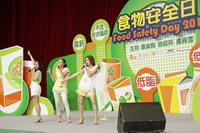
The schools participating in Food Safety Day 2010 formed teams to take part in the Nutrition Labelling Creative T-shirt Design Competition and Nutrition Labelling Group Photo Competition. The students became models of their creative T-shirts submitted for the competition in the Catwalk Show and their terrific performance received thunderous applause and loud cheers from the audience. Other activities included performance by young singers and music groups to promote nutrition labelling through songs and interactive games.
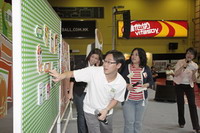 |
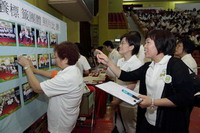 |
To tie in with the implementation of the new Nutrition Labelling Scheme and to enhance understanding of the Scheme among the trade and the public, the CFS will continue to conduct a variety of promotional activities, which include talks and workshops on the Scheme in community halls, civic centres and libraries and roving exhibitions in housing estates and shopping malls, with a view to introducing and promoting nutrition labelling to the public. Moreover, the CFS has produced TV and Radio Announcements of Public Interest and radio plays so that the public can receive nutrition labelling messages at home. Other promotional activities include advertisements on public transport and production and distribution of promotional leaflets, posters, booklets and souvenirs to various trades and organisations like hospitals, clinics and schools. Lastly, relevant information and online games are provided at the dedicated web page of the CFS on the Nutrition Labelling Scheme (www.nutritionlabel.gov.hk) for the public and will be updated on an ongoing basis.

The CFS aims to engage the trade and the public in various activities it organises by which means they can learn about nutrition labelling of prepackaged foods and apply such knowledge in their daily life to make smarter food choices. The CFS aims to further promote use of Nutrition Labelling in support of healthy living in Hong Kong through tripartite cooperation among the public, the trade and the Government.
 |
 |
 |
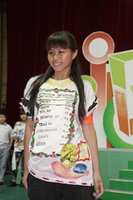 |
Food News
Turn and Look for Healthier Food Choices
Nutrition Labelling Series – A Panorama of Nutrition Claims
In addition to regulating nutrition labels on prepackaged foods, the amended Food and Drugs (Composition and Labelling) Regulations (refers to the "Nutrition Labelling Regulation" hereunder) which came into effect on 1 July 2010 also regulates nutrition claims on prepackaged foods. In this issue, we will go through different types of nutrition claims, the general control of nutrition claims and how to make use of nutrition claims.
Three Main Types of Nutrition Claims
"Nutrition Claim" means any representation involving energy and nutrients which states, suggests or implies that a food has particular nutritional properties. There are three main types of nutrition claims under the Nutrition Labelling Regulation, namely nutrient content claim, nutrient comparative claim and nutrient function claim.

- A nutrient content claim is related to the content of a nutrient found in a food. It describes the content level of a nutrient contained in a food, e.g. "low fat".
- A nutrient comparative claim is also related to the content of a nutrient found in food. Rather than describing the nutrient content level, a nutrient comparative claim compares the nutrient content levels of two or more similar types of food, e.g. "Reduced fat - 25% less than the regular product of the same brand".
- A nutrient function claim describes the physiological role of a nutrient in growth, development and normal functions of the body, e.g. "Calcium builds strong bones.".
Regulation on Nutrition Claims
- The control of nutrition claims is not limited to nutrition claims made on labels on prepackaged foods, but also covers any nutrition claims in any advertisement.
- The amount of those nutrients that are the subjects of nutrition claims must be included in the nutrition label. For instance, if a "high calcium" claim is made, the amount of calcium must be listed in the nutrition label. Also, if a nutrition claim is made on fat (e.g. total fat, saturated fat and trans fat), the amount of cholesterol must be provided on the nutrition label as well.
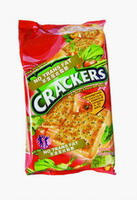
How to Make Use of Nutrition Claims
Nutrition claims can only be used as a quick reference only. Consumers should not focus only on the claimed nutrients, but should refer to the nutrition label for detailed information on the overall nutritional property of the food products for making healthy food choices.
For instance, although a product with a "low fat" claim should have a low enough fat content in order to bear such claim, consumers should refer to the nutrition label to ascertain that the product does not have high contents of sugars nor sodium, so as to make healthier food choices.
Food Safety Plan Corner
Steamed Scallops with Vermicelli – Critical Control Point
Critical Control Point of Preparing Steamed Scallops with Vermicelli (for Food Trade)
Seafood is delicious and nutritious. Among others, scallop is a kind of shellfish that many people enjoy eating. However, it is vulnerable to contamination caused by bacteria (e.g. Vibrio parahaemolyticus), viruses (e.g. Norovirus) and toxins (e.g. Paralytic Shellfish Poisoning (PSP) toxins) in water. In the following, we provide guidelines on preparing the popular Chinese dish, Steamed Scallops with Vermicelli. We hope you can ensure food safety so your customers can enjoy the food safely.
What is Paralytic Shellfish Poisoning (PSP)?
PSP is caused by consumption of shellfish containing PSP toxins. The onset of poisoning symptoms is usually within minutes to hours after ingestion of contaminated bivalves (e.g. scallops). The symptoms, predominantly neurological, include tingling, numbness, burning of the perioral region, fever, rash and staggering etc. accompanied by gastrointestinal symptoms. While recovery is usually achieved within a few days, muscle paralysis, respiratory arrest and even death may occur in severe cases.
| Ingredients | |
| Fresh scallop | 6 pieces |
| Vermicelli | 50 grams (about 2 taels) |
| Seasoning | |
| Minced garlic | 5 grams |
Steps:
- Rinse and scrub the shells of the scallops. Remove the upper shell and viscera and drip dry.
- Soak vermicelli in boiled water until soft. Drip dry for later use.
- Top scallop flesh with vermicelli and minced garlic. Steam on high heat for about 10 minutes until cooked.
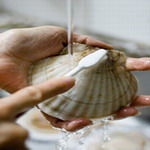 |
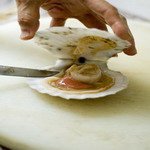 |
|
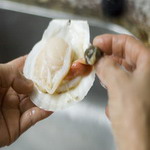 |
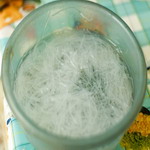 |
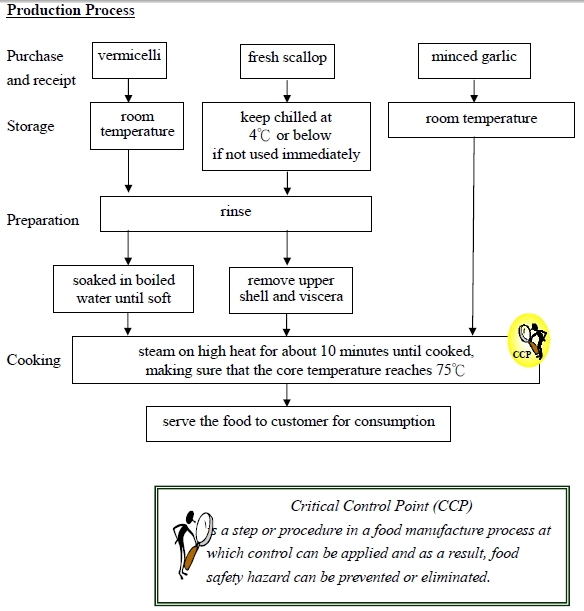
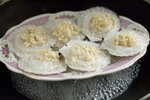
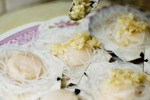
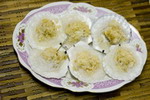
Guidelines on Production of Steamed Scallops with Vermicelli
- (1) Purchase and receipt
- Purchase the ingredients from reliable and hygienic suppliers.
- When buying and receiving the ingredients, make sure that the ingredients are fresh and wholesome.
- Choose fresh scallops with shells that are intact and slightly open. They should close up tightly and even have water sprayed out when tapped.
- All prepackaged food items (e.g. vermicelli) are used before the expiry date.
- Storage
- Store the ingredients at safe temperature as soon as possible.
- Scallops not for immediate cooking should be put in a container with a lid and stored in a refrigerator.
- Store raw food and cooked food in different refrigerators.
- The temperature inside the refrigerator should be checked and recorded regularly with a thermometer to ensure that the fridge remains at 4℃ or below.
- Practise the first-in-first-out principle for storage. Check and record the storage date of the ingredients.
- Store the ingredients at safe temperature as soon as possible.
- Preparation
- Before cooking, wash all food contact surfaces (including worktops, chopping boards and utensils, etc.) and the hands thoroughly.
- Use two different sets of utensils (including knives, chopping boards, bowls and chopsticks) to handle raw food and cooked food separately.
- Before cooking, rinse the scallops and vermicelli. Scrub the shells and remove the viscera of the scallops.
- Cooking
- The food should be thoroughly cooked before consumption. Scallops must be cooked until they do not appear translucent. The core temperature should reach at least 75℃. (Critical Control Point; CCP)
- Serve the food to customers for consumption
- The cooking liquid should be discarded before the food is served to customers for consumption.
Prevention of PSP
- PSP toxins are heat-stable and cannot be destroyed through cooking.
- The level of PSP toxins can be greatly reduced by removing the viscera of scallops before cooking and discarding the cooking liquid before serving the food to customers for consumption.
- Management System
- Implement a preventive food safety management system (such as the Hazard Analysis and Critical Control Point) to help identify and control any food safety problems that may emerge during production.
Readers' Corner
(1) Recent CFS Activities
Between July to October, the CFS held a series of seminars on "5 Keys to Food Safety" to promulgate proper food handling. During the seminars, the Hazard Analysis and Critical Control Point (HACCP) System was discussed. The food trade was encouraged to implement food safety plans in the production of food so as to raise food safety standard. To tie in with the implementation of the Nutrition Labelling Scheme on 1 July 2010 , the seminars also introduced the new Scheme and the application of nutrition labelling in daily life. A total of 18 seminars were held in different districts in Hong Kong for frontline staff of the food trade.
How to correctly use polyfoam boxes to contain food?
When a plastic container like polyfoam box comes into direct contact with food, it may release substances contaminating the food, depending on the food characteristics, food temperature and duration of contact. Therefore, it is very important to use plastic containers correctly.
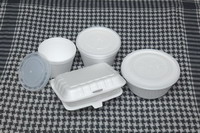
Disposable containers commonly used in Hong Kong are often made with polypropylene (PP), expanded polystyrene (EPS, commonly known as polyfoam), polystyrene (PS) or polyethylene terephthalate (PET). Among them, PP can withstand temperature ranging from 100 ℃ to 120 ℃ for a long period, whereas the other three types of plastics are not suitable for keeping food at temperature over 100 ℃ . In the past, the FEHD had conducted a safety study on samples of disposable plastic food containers. The findings showed that if properly used, they would unlikely cause food safety problems.
When choosing a disposable plastic container, one should consider the characteristics of the food to be contained (e.g. whether the food is acidic or fatty), the food temperature and duration of contact, and check the materials used for manufacturing the container as labelled on its bottom in order to choose a suitable container and container lid.
Besides, stakeholders in the trade may:
- refer to the "Guidelines on the use of disposable plastic containers" published by the FEHD
( http://www.cfs.gov.hk/english/multimedia_pub/multimedia_pub-pm_ftc.html); - refer to the Consumer Goods Safety Ordinance, Cap. 456 (www.elegislation.gov.hk); or
- contact the Customs and Excise Department for enquiry (telephone hotline: 2815 7711; email address: customsenquiry@customs.gov.hk)
(3) Facts and Myths
| Daughter: |
Mom! Look, I have bought some giant fresh scallops for our meal. Please remember to remove all their viscera before cooking and discard any cooking liquid before consumption. |
| Mom: |
Is it that as long as the scallops are cleaned and cooked thoroughly, consuming them will not give rise to food poisoning? |
| Daughter: |
Not really! Apart from bacteria, contaminated shellfish may contain heat-stable toxins (especially in the viscera) that cannot be destroyed even after thorough cleaning and cooking. These toxins are more often found in guts, can also be dissolved in the cooking liquid. Therefore, the guts, gonads and the cooking liquid should be removed. |
| Mom: |
OK. Let's work on it now ! |
(4) Brain Gym (Chinese version only)
Enquiry and Subscription
Printed copies of the Food Safety Express can be collected at the Communication Resource Unit located at 8/F, Fa Yuen Street Municipal Services Building, 123A Fa Yuen Street, Mong Kok, Kowloon. For enquiry, please call 2381 6096. The public may also visit the website of the Centre for Food Safety (http://www.cfs.gov.hk) for the online version.
